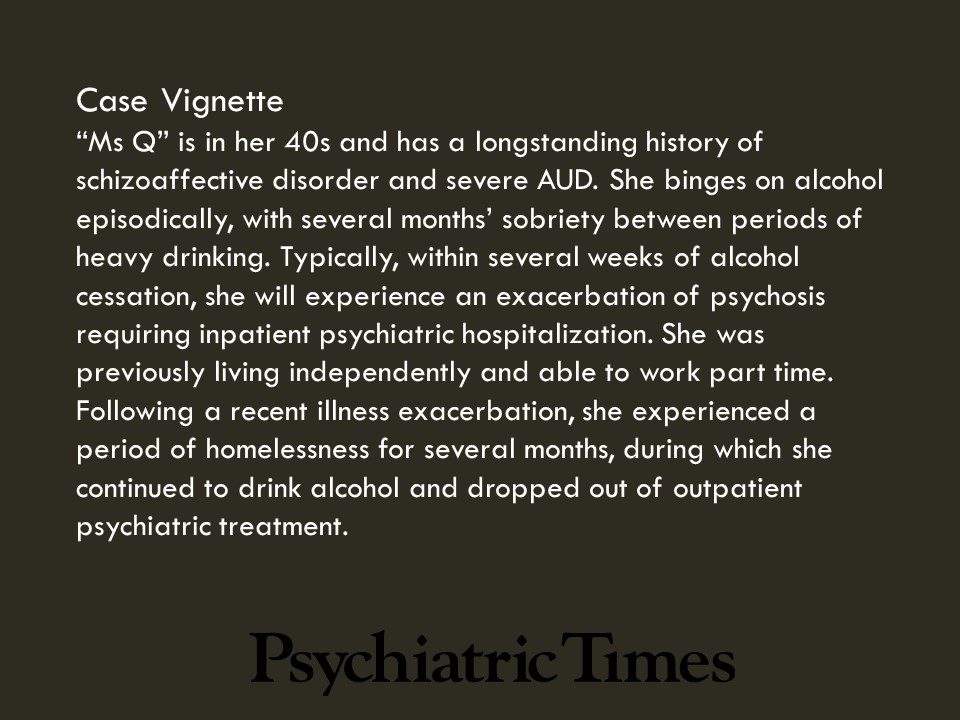Article
The Clinical Course of Schizophrenia With Comorbid Alcohol Use Disorder
Author(s):
Schizophrenia is associated with an increased prevalence of alcohol use disorders. A post-hoc analysis of the clinical course of the 2 disorders is an important change in this understudied and often overlooked population.
MontiraAreeponthum/Shutterstock

RESEARCH UPDATE
Schizophrenia is associated with an increased prevalence of alcohol use disorder (AUD),1 which is associated with relapse2 and poorer outcomes.3 Unfortunately, adherence with (limited) treatment options for this patient population are suboptimal. Furthermore, patients with comorbid AUD are often excluded from clinical pharmacologic trials in schizophrenia. Therefore, this represents and understudied and difficult-to-treat patient population.
The NIMH-funded Clinical Antipsychotic Trials of Intervention Effectiveness (CATIE) was a large, long comparative trial of antipsychotics for the treatment of schizophrenia.4 As an effectiveness trial, CATIE did not exclude patients with substance use comorbidity.
Pathak and colleagues5 reported on a post-hoc analysis of the course of illness in patients with schizophrenia and AUD from the CATIE study. They assessed time to first and recurrent exacerbation, and risk of first and current hospitalization in these patients within the 5 years before study entry, compared with patients with schizophrenia only. They also compared treatment outcomes with olanzapine versus other antipsychotics in these 2 groups. The authors hypothesized that schizophrenia and AUD would have a worse outcome than patients with schizophrenia, and within each group the advantages of olanzapine for exacerbations and hospitalizations in the CATIE study would be retained.
Data for the study were obtained from the publicly available, limited access CATIE study dataset from the NIMH. Briefly, CATIE was an 18-month double-blind, randomized trial of perphenazine and olanzapine, quetiapine, risperidone, and ziprasidone in 1493 patients with schizophrenia.The primary endpoint was time to all-causes discontinuation.
Patients were categorized into schizophrenia and AUD (based on DSM-IV criteria) and schizophrenia-only groups. The authors excluded 155 patients with non-alcohol substance use disorders, except for marijuana use, which was permitted. Exacerbation was defined as hospitalization for psychopathology; > 25% or 15-point increase in baseline PANSS total score; or significant worsening of key PANSS items, clinically significant aggression or suicidal/homicidal ideation, use of rescue medication, emergency department visit, discontinuation due to lack of efficacy, and arrest or incarceration. Time to first and recurrent exacerbations and hospitalizations were compared between the 2 subject groups, including the reasons leading to exacerbations. In the schizophrenia and AUD group, exacerbations and hospitalizations were compared between olanzapine and the other antipsychotics. Data were analyzed using Cox proportional hazards and Andersen-Gill models. Kaplan-Meier plots were presented for time to first even analyses.
There were 303 (23%) participants in the schizophrenia and AUD group and 1035 (77%) in the schizophrenia group. Patients with schizophrenia and AUD were significantly younger, had a lower BMI, were more likely to be male (87% versus 70%), and had a greater number of hospitalizations in the year prior to study entry than those with schizophrenia only. There was little difference in the prevalence of marijuana use between the 2 groups (6% versus 8%).
The time to first exacerbation (HR = 1.20) and time to first hospitalization (HR = 1.63) were both significantly shorter in schizophrenia and AUD than schizophrenia only. A similar finding was observed for recurrent hospitalizations (HR = 1.60), although there was only a trend for between-group differences in recurrent exacerbations (HR = 1.16). Over half (61%) of patients with schizophrenia and AUD had an exacerbation, compared with 52% in the schizophrenia-only group, and these patients were more likely to have an exacerbation resulting in hospitalization for psychopathology, due to aggression or suicidal/homicidal ideation, or arrest or incarceration.
Overall, perphenazine, quetiapine, risperidone, and ziprasidone were all associated with a significantly shorter time to first exacerbation compared with olanzapine (HRs = 1.81 to 2.80). A similar pattern of findings was observed for time to first hospitalization.
The authors concluded that patients with schizophrenia and AUD had a poorer course of illness with higher risk of disease progression compared to patients with schizophrenia without AUD comorbidity. They also found that olanzapine may be associated with longer time to first and recurrent exacerbations compared to other treatment in patients with schizophrenia and AUD comorbidity. Strengths of the present study include the large number of subjects and the “real-world” design of the CATIE trial. Potential limitations include the post-hoc nature of the analysis, and the lack of generalizability of findings to patients with schizophrenia and other (non-alcohol) substance use disorders. Future trials are needed to identify effective treatment for this patient population.
The bottom line
Patients with schizophrenia with (versus without) alcohol use disorder comorbidity have a worse course of illness, and olanzapine may be associated with a longer time to exacerbations versus other non-clozapine antipsychotics.
Case Vignette 1
“Ms Q” is in her 40s and has a longstanding history of schizoaffective disorder and severe AUD. She binges on alcohol episodically, with several months’ sobriety between periods of heavy drinking. Typically, within several weeks of alcohol cessation, she will experience an exacerbation of psychosis requiring inpatient psychiatric hospitalization. She was previously living independently and able to work part time. Following a recent illness exacerbation, she experienced a period of homelessness for several months, during which she continued to drink alcohol and dropped out of outpatient psychiatric treatment.
Case Vignette 2
“Mr G” is in his 30s and had a history of chronic schizophrenia and severe AUD, as well as cannabis use disorder. He is currently serving a 1-year probation for a DUI. He is adherent with monthly administration of a long-acting injectable antipsychotic but continues to drink alcohol and smoke marijuana regularly. He lives at home with his parents and is chronically unemployed. He has not had a psychiatric hospitalization in many years but remains pre-contemplative regarding the need for treatment for substance use disorder.
Dr. Miller is Professor, Department of Psychiatry and Health Behavior, Augusta University, Augusta, GA. He is the schizophrenia section chief for Psychiatric Times®. The author reports that he receives research support from Augusta University, the National Institute of Mental Health, the Brain and Behavior Research Foundation, and the Stanley Medical Research Institute.
References
1. Hartz SM, Pato CN, Medieiros H, et al. Comorbidity of severe psychotic disorders with measures of substance use. JAMA Psychiatry. 2014;71:248-254.
2. Bradizza CM, Stasieqicz PR, Dermen KH. Behavioral interventions for individuals dually-diagnosed with a severe mental illness and a substance use disorder. Curr Addict Rep. 2014;243-250.
3. Jones RM, Lichtenstein P, Grann M, et al. Alcohol use disorders in schizophrenia: a national cohort study of 12,653 patients. J Clin Psychiatry. 2011;72:775-779.
4. Lieberman JA, Stroup TS, McEvoy JP, et al. Effectiveness of antipsychotic drugs in patients with chronic schizophrenia. N Engl J Med. 2005;353:1209-1223.
5. Pathak S, Jian Y, DiPetrillo L, et al. Course of Psychosis in Schizophrenia With Alcohol Use Disorder. J Clin Psychiatry. 2020;81:2.







